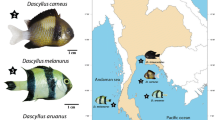Summary
The study of the structural organization of the eukaryotic genome is one of the most important tools for disclosing the evolutionary relationships between species.Artemia (Crustacea, Phyllopoda) offers a very interesting model for speciation studies. The genus, distributed all over the world, comprises both bisexual sibling species and parthenogenetic populations, exhibiting different chromosome numbers (diploidy, polyploidy, and heteroploidy).
Digestion of genomic DNA of the parthenogeneticArtemia sp. from Tsing-Tao (China) with the restriction enzymes Eco RI and Alu I reveals that a highly repetitive sequence of 133 bp is present. The Eco RI fragment has been cloned and characterized by genomic organization. The distribution of the Eco RI family of repeats was also studied in several bisexual and parthenogeneticArtemia populations and compared with an Alu I repetitive fragment previously identified inArtemia franciscana.
Similar content being viewed by others
References
Badaracco G, Baratelli L, Ginelli E, Meneveri R, Plevani P, Valsasnini P, Barigozzi C (1987) Variations in repetitive DNA and heterochromatin in the genusArtemia. Chromosoma 95:71–75
Barigozzi C, Badaracco G, Plevani P, Baratelli L, Profeta S, Ginelli E, Meneveri R (1984) Heterochromatin in the genusArtemia. Chromosoma 90:332–337
Beridze TG (1986) Satellite DNA. Springer-Verlag, Berlin
Bonner JJ, Pardue ML (1976) Ecdysone-stimulated RNA synthesis in imaginal discs ofDrosophila melanogaster. Chromosoma 58:87–99
Brutlag DL (1980) Molecular arrangement and evolution of heterochromatic DNA. Annu Rev Genet 14:121–144
Brutlag DL, Appels R, Denuis ES, Peakok WJ (1977) Highly repeated DNA inDrosophila melanogaster. J Mol Biol 112:31
Cruces J, Wonenburger MLG, Diaz-Guerra M, Sebastian J, Renard J (1986) Satellite DNA in the crustaceanArtemia. Gene 44:341
Dover G (1982) A role for the genome in the origin of species. In: Barigozzi C (ed) Mechanisms of speciation. Liss, New York, pp 435–459
Hennig W (1972) Highly repetitive DNA sequences in the genome ofDrosophila hydei II. Occurrence in polytene tissues. J Mol Biol 71:419–431
John B, Miklos GLG (1979) Functional aspects of satellite DNA and heterochromatin. Int Rev Cytol 58:1–114
Lohe AR, Brutlag DL (1987) Identical satellite DNA sequence in sibling species ofDrosophila. J Mol Biol 194:161
Maniatis R, Fristch EF, Sambrook J (1982) Molecular cloning. A laboratory manual. Cold Spring Harbor Press, Cold Spring Harbor NY
Mazrimas JA, Hatch FT (1972) A possible relationship between satellite DNA and the evolution of kangaroo rat species (genusDipodomys). Nature New Biol 240:102–105
Messing J, Crea R, Seeburg PH (1981) A system for shotgun of DNA sequencing. Nucleic Acids Res 9:309–321
Salsen W, Bowen S, Browne D, El Adli F, Fedoroff M, Fry K, Henidell H, Paddok G, Poon R, Wallace B, Whitcome P (1976) Investigation of the organization of mammalian chromosomes at the DNA sequence level. Fed Proc 35:23–35
Sanger F, Nicklen A, Coulson AR (1977) DNA sequencing with chain-terminating inhibitors. Proc Natl Acad Sci USA 74:5463–5467
Singer MF (1982) Highly repeated sequences in mammalian genomes. Int Rev Cytol 76:67–112
Southern EM (1975) Detection of specific DNA sequences among DNA fragments separated by gel electrophoresis. J Mol Biol 98:503–527
Southern EM (1979) Base sequence and evolution of guinea-pig α-satellite DNA. Nature 227:794–798
Walker PMB (1968) How different are the DNAs from related animals? Nature 219:228
Walker PMB (1971) “Repetitive” DNA in higher organisms. In: Butler JAV, Moble D (eds) Progress in biophysics and molecular biology, vol 23. Pergamon, Oxford, pp 147–190
Author information
Authors and Affiliations
Rights and permissions
About this article
Cite this article
Badaracco, G., Tubiello, G., Benfante, R. et al. Highly repetitive DNA sequence in parthenogeneticArtemia . J Mol Evol 32, 31–36 (1991). https://doi.org/10.1007/BF02099926
Received:
Issue Date:
DOI: https://doi.org/10.1007/BF02099926




